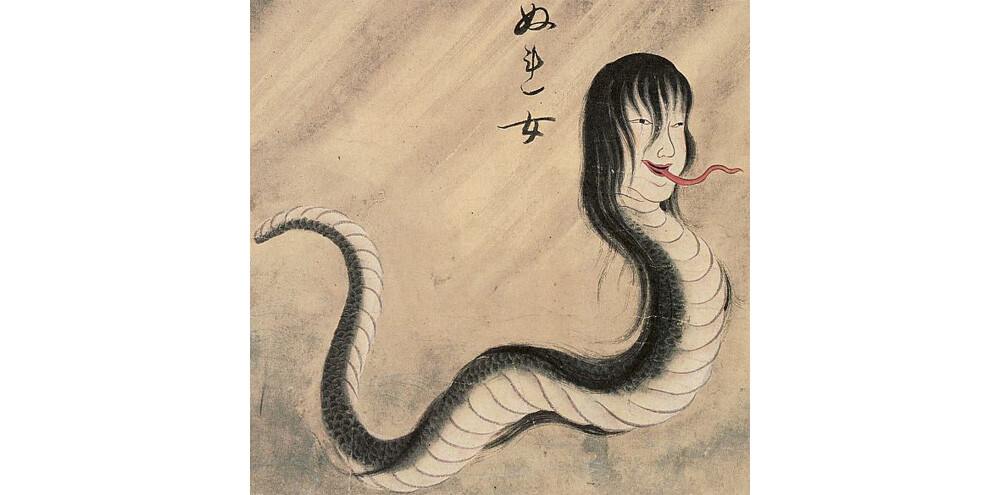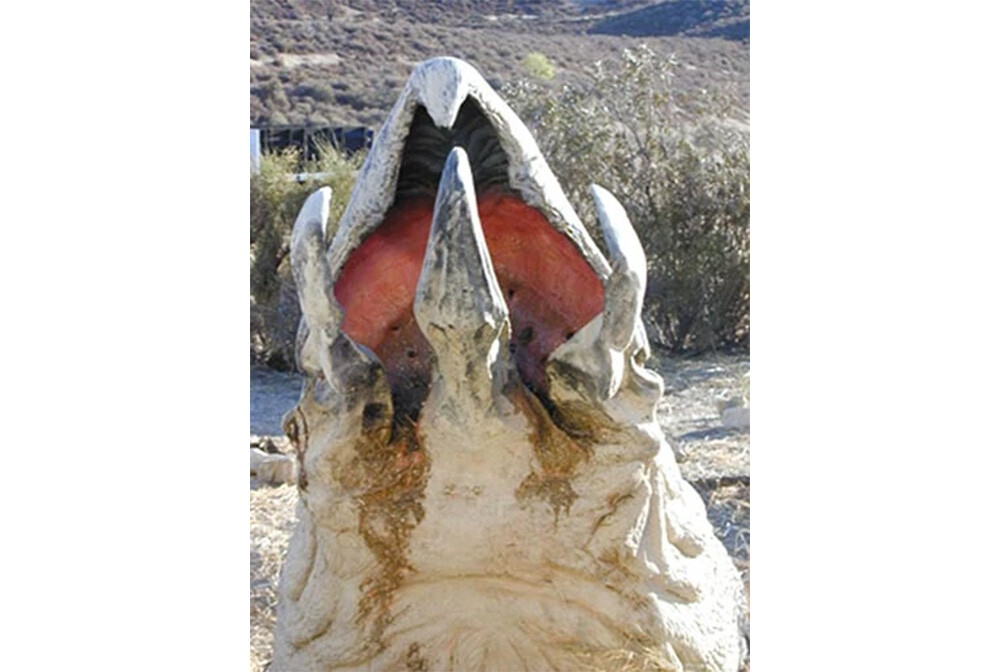5 Creepy Creatures And Nightmare Fuel From Foreign Folklore

Monsters are like porn. There eventually comes a time when you get bored with the normal stuff like vampires, zombies, or werewolves and want to spice things up a bit. And whether you're looking for new ways to scream or cream, your first stop should always be foreign countries where you can easily find stuff that was deemed too extreme for the US market, like …
Ushi-Oni And Nure-Onna: Japan’s Damned Double-Act Of Doom
Nure-Onna is a great example of an Ostrich Smoothie. I'm trying to make that a thing, so go along with me for a while. So, there's an iCarly episode where a character buys an ostrich and when asked what he has there, gestures to the beverage in his hand and answers, "A smoothie." I mean … he was technically correct but also leaving out some very important stuff. That's what Nure-Onna is all about. She's a monster from Japanese mythology whose name literally means "wet woman" on account of her living near bodies of water and thus always being drenched. Technically, the name checks out.
Don't Miss
However, she also has the body of a snake, uses a magic baby as bait, and eats humans. Like I said. Ostrich Smoothie.

“She has bangs.”
The description of Nure-Onna (or Wetty Betty, if you will) differs from region to region. Sometimes she's human from the waist up with a monstrous snake tail where her legs should be, like H.R. Giger's take on The Little Mermaid, and sometimes she's just a head on a snake body. However, Nure-Onna can use magic to make herself appear as a human woman holding a baby. And that's how she gets you.
Once she spots her victim, she magics herself into a mother in distress, calls for help, and then asks you to hold her baby while she pops to the store for some diapers or whatever. And then you're left raising the kid until they're 18! AAAAHHHHH! The horror! Just kidding! Nothing that horrible. Nah, the "baby" just turns into a stone that you can't let go of, trapping you while the snake woman eats you and drinks your blood.

Using human kindness as a weapon is pretty effed up, but it gets worse. Giant demon-ox-spider worse. That's the worst kind.
If you ever fall victim to Nure-Onna, you better pray you die before her dinner guest arrives. In many myths, the wet bandit tends to share her meals with Ushi-Oni. Its name literally means "Ox Demon," but it's really just another Ostrich Smoothie because, yeah, the monster does have the head of a demon-ox, but that head is attached to the body of a giant spider.

Same as Nure-Onna, Ushi-Oni likes to live near the water and loves having people for dinner together with Dame Judy Drench but what's weird is that no myth explains WHY. Like, Nure-Onna does all the work luring in people and all that, yet she allows the Cow Spider to join her. This leads us to only one logical conclusion: the two are banging. Now try to imagine what that looks like (and then try aiming for the trashcan.)
Slavic Female Demons Sound Like An Excuse For Horrible Domestic Abuse
Slavic female demons that occupied swamps, lakes, forests, and mountains went by many names, with each of them kind of sounding like a very specific-yet-weirdly-popular type of porn. A female demon from Poland, Russia, Czechia, or Slovakia, etc. was known as a boginka (~" goddess"), dziwozona (~" wild woman"), or mamuna (~" temptress"), and, to be fair, they sometimes did appear as beautiful, naked, young women.

Theeeeen again, they more often looked like old crones covered in hair, with massively sagging breasts and nipples so long, they had to sling them over their shoulders. When they weren't using them to do their laundry. No, really, ancient Slavs apparently felt it important to point out that female demons looked like Bigfoot's grandma and liked to give saggy boob-jobs to their clothes to wash them. Again, please try to aim for the trashcan.
Women could become a boginka, dziwozona, or mamuna by dying in childbirth, committing suicide, or killing their child. After the transformation, they liked to target young women, kidnapping them and beating them with sticks, dunking their heads in mud, and twisting their arms before ultimately returning them home … Which really sounds like a weirdly convoluted, ancient-Slavic version of "I walked into a door."
A lot of the myths surrounding Slavic female demons were actually meant to explain the difficult/unfortunate parts of life in a time when medicine boiled down to: "Sounds like you have goblins in your blood. Here's some vodka." So the demons became the explanation for new mothers suddenly becoming sad, anxious, or irritable because back then, it just made more sense than, “What did you call it? 'Postpartum depression?' What's that; a spell or something?”
A boginka/dziwozona/mamuna could also kidnap your child and replace it with a changeling, which would grow up with mental and physical disabilities because "Genes?" "DNA?" those sound like devil words. A nice solid beating will cure you of that.

Actually, that was one of the ways to deal with a changeling. You were supposed to take your "imposter baby" at midnight to somewhere where the demons lived and just start hitting it with sticks. With luck, the demons would feel bad about their own child getting hit and would switch it back with the original. If your kid was still crying too much at night or whatever, it meant you didn't whip "the changeling" hard enough. Now, if you'll excuse me, I'm gonna weep in the corner for a bit because joking about babies getting hurt gets really hard after you've become a parent.
The Pishtaco Are The Embodiments Of The Andes’ Colonial Trauma
I'll give you a few minutes to laugh at the name "pishtaco," which I suggest you do because things are going to get super gruesome super fast after that. So enjoy yourself while you still have time.
"Pishtaco" comes from the South American Quechua-language "pishtay," meaning "to cut up/slaughter," and refers to a particularly effed up kind of vampire: one that steals your fat. A lot of cultures around the world have stories of supernatural creatures that steal your essence, which in most places is symbolized by blood. But in the isolated Andes, it was fat that was considered the gooey source of life because it meant you were wealthy enough to buy your way out of the super unfun game that most humans have been playing for centuries called Starving to Death. The reverence of fat actually goes back to the dawn of human civilization, but the people of the Andes took it in a particularly disturbing direction with the stories of the terrifying pishtaco.

The legends of these creatures go back to 1574 and have varied over time. Sometimes the pishtaco would slash you with their razor-sharp fingernail and perform a little paranormal liposuction until you could be buried in a coffin the width of a broom handle. Other times he would cut you open with a knife, scoop out your fat, and sell it as medicine or oil for greasing metal parts. In other versions, the pishtaco would first put you to sleep using a powder made from human bones. But throughout the many retellings of these stories, one thing remained constant, and that's the pishtaco looking like a white man.
The "pishtaco" boogeymen were created after the people of the Andes ran into Spanish conquistadors in the 16th century and saw them using the fat from slain enemies to treat their wounds. This was actually standard medical practice in Europe at the time, but to people who venerated fat, it looked like the most messed up thing in the world. Which, to be fair, it kinda was. But then the Spaniards made things even worse.

According to some stories, the Spaniards struggled with their muskets and cannons rusting in the damp South American weather, so they started boiling the bodies of the killed natives for fat to grease their weapons. Seeing all of this left its traumatic mark on the region, with stories of the Tyler Durden-esque paranormal creature continuing well into the 21st century.
In the past, Caucasian anthropologists and aid workers were reportedly chased out of some villages after being accused of being "pishtaco," though the term is mostly used nowadays as a metaphor for the exploitation of South America by the West. Because the real monster in these myths *holds up flashlight under face* has been colonialism all along.
Tupilaq Is Greenland’s Blowjob Frankenstein
Do you hate someone? I mean, really, REALLY hate someone? Shut up; no, you don't. You don't know what real hate is. The pre-Christian Inuit people of Greenland knew, though, because they were willing to go to disturbing lengths to get back at someone who had wronged them. Ask yourself this: would you be willing to get a blowjob from a Doctor Moreau-esque Frankenstein to kill your worst enemy? Then sit your ass down, and maybe you'll learn what real, pure hatred looks like.

In most Inuit cultures, the tupilaq/tupilak was a vengeful invisible ghost that only a shaman could see. In Greenland, though, it was unfortunately visible. I say "unfortunately" because the Greenlandic tupilaq was a physical creature that had to be constructed by a sorcerer/shaman from animal bones, skin, sinew, etc., but it apparently worked better if you threw in a bunch of human bones into it as well. Some sources say children's bones worked best. Add a sprinkle of something that belonged to your enemy, and, voila, you had yourself a nightmarish magic assassin that looked like … Well, it depended.
Since a tupilaq was made from biodegradable parts (hey, just because you're on an insanity-induced vendetta doesn't mean you can't be eco-friendly), no actual examples survived, but native artists have made reproductions of the creatures. Some were anthropomorphic, but most resembled Greenland's fauna like walruses, whales, and other animals … if they were redesigned by Satan to also act as a cure for constipation.

Anyway, a few ritualistic chants later, and the tupilaq would come to life, go into the sea, and kill your enemy. As long as the enemy wasn't magically stronger than you; otherwise, the tupilaq would turn around and kill you. It kind of had really good reasons to hate its maker.
See, the chants brought the tupilaq to life, but the shaman still had to imbue it with his magical power. And you know the old saying: the quickest way to a man's magic depository is through his genitals. As in, the tupilaq had to suck out its creator's magic power out of his dong. The quasi-incestuous/necrophiliac undertones aside, remember that these things were often made with fangs and tusks the size of T-Rex teeth, so you really had to despise someone in order to send a tupilaq after them.

So, no, you don't "hate" Brian for stealing your clearly marked lunch from the breakroom fridge. Not unless you're willing to get a blowjob from a bad-acid-trip reboot of Pinocchio in order to get back at him.
Tokoloshe: Like A South African Graboid … Only Smaller … And Actually The Penis Of A Goblin
The tokoloshe is a creature from Zulu mythology that frequently appears in the legends around South Africa. It's essentially a familiar: a magical creature created/controlled by a witch or shaman to do their bidding. It either looks like a monkey or goblin and, hey, so far so not-puking-in-a-trashcan! Unfortunately, we now have to mention tokoloshe's penis.
It's gigantic. Like ridiculously huge. We're talking about "mistaken for a third leg" big. Logically, the tokoloshe should violently pass out whenever it gets an erection because it would take all the blood in its body to inflate that fireman's hose-sized flesh balloon. But it somehow manages to stay awake while getting a boner which is a problem because the tokoloshe apparently is horny 25/8, 369 days a year. It's why the witch that brings it to life has to have regular sex with the goblin, so it stays by her side and does what she asks for.

Also, the tokoloshe are created by jabbing a red-hot poker into their heads to make a hole and sometimes even have their eyes gouged out. So, the least the witch can do is ride its unholy abomination's magic broom for a while. It's just common courtesy.
But getting to bang their boss is often not enough to satisfy the tokoloshe, and they apparently go on frequent rape sprees targeting men and women. They have a lot of ways to get inside a house, but the most disturbing one by far is their ability to extend and drill their penises underground, where they will travel like smaller yet somehow more terrifying graboids from Tremors. The dick-worm will burrow as long as it needs to find a victim, then it will pop out of the ground and commence its sexual assault.

Universal Pictures
This is the part where we, sadly, have to mention that despite the ridiculous description of the monster, "tokoloshe" is a serious matter because it's still sometimes blamed for real rapes perpetrated by real people. I guess the ultimate lesson here is: Reality may not actually be stranger than fiction, but it's always much more depressing.
Follow Cezary on Twitter.
Top image: Brigham Young University
